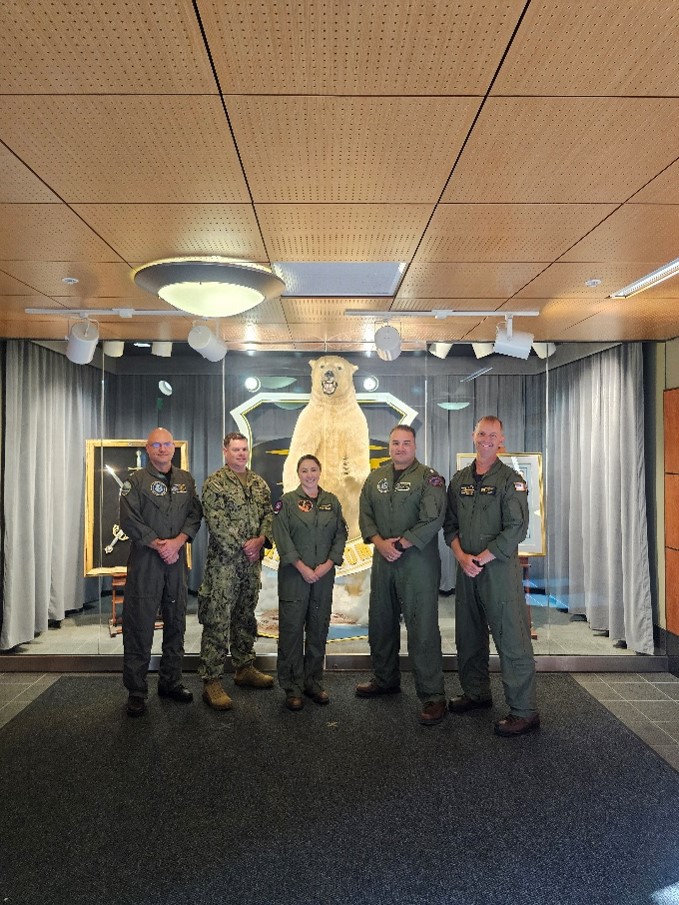
NEWS | Nov. 6, 2024
U.S. Navy Reserve 3rd Fleet Leads NALE at POLAR VORTEX
By Lt. Cmdr. Kristine Volk, U.S. 3rd Fleet Navy Reserve Public Affairs and Tech. Sgt. Donald Hudson, Alaskan NORAD Region Public Affairs
JOINT BASE ELMENDORF-RICHARDSON, ALASKA, UNITED STATES – During Operation POLAR VORTEX, a Naval and Amphibious Liaison Element (NALE) led by U.S. 3rd Fleet and supported by U.S. Fleet Forces was embedded into the bi-national Alaskan North American Aerospace Defense Command (NORAD) Region to manage the integration of naval and air activity at Joint Base Elmendorf-Richardson, Alaska.
The NALE is primarily a function of the Navy Reserve, with Reserve personnel filling roughly 98 percent of NALE billets, given the operational tempo of this unique work. NALE Sailors train in mobilization to billet (MOB-to-billet) positions and generally deploy on 90 to 270-day orders, responding both to planned operations and emergent crises, including training exercises, freedom of navigation operations, and humanitarian assistance and disaster relief to enable better integration between joint air assets. The NALE provides the necessary face-to-face contact among planner, commanders and staff to ensure mutual understanding, unity of effort and reduce friction between components.
“U.S. 3rd Fleet Navy Reserve members play a vital role in the NALE and give our fighting forces a competitive advantage by offering critical strategic depth to support the high-end fight,” said Rear Adm. Richard W. Meyer, deputy commander, U.S. 3rd Fleet. “I’m so proud of our Navy Reserve warfighters. They’re our most valuable resource and were essential to our integrated operations in the Northern Pacific. Leveraging their civilian career experience and diverse backgrounds, they added tremendous value to deliver warfighting advantage and expertise to the U.S. Navy, Joint and Combined Force.”
U.S. Air Force and Royal Canadian Air Force (RCAF) members in the 611th Air Operations Center worked alongside the 3rd Fleet NALE to increase multi-domain awareness in the Arctic region during Operation POLAR VORTEX by instantly linking maritime and air domain awareness.
By co-locating while in Alaska, the 3rd Fleet NALE and 611th AOC were able to immediately coordinate information for the Joint Force Air Component Commander (JFACC) and provide a detailed real-time operating picture from the surface to air across some of the most remote operating areas in Alaska.
“The NALE has been essential to air operations,” said RCAF Brig. Gen. David Moar, deputy commander, Alaskan North American Aerospace Defense Command NORAD Region. “They were key in synchronizing air operations with naval air assets and providing information to enable the JFACC to coordinate and support the maritime component.”
The NALE worked to seamlessly integrate their expertise of maritime domain awareness and employ a Navy P-8 Poseidon alongside joint and bi-national air assets. The cooperation increased tactical performance of joint forces validating command and control and tactical execution of mission objectives between various aircraft including exercising simulated air-to-surface strikes.
“The situational awareness the NALE has provided is the most maritime awareness the AOC has had in the 14 years I’ve been here,” said Alaska Air National Guard Col. Jeff Smith, deputy commander, 611th AOC. “It’s been great to see the coordinated efforts between air and maritime domains.”
U.S. 3rd Fleet operations in U.S. Northern Command’s (USNORTHCOM) area of responsibility throughout the Gulf of Alaska aligned with Commander, U.S. Pacific Fleet objectives to demonstrate resolve and credible deterrence in defense of the homeland in the area. The operations also supported USNORTHCOM and NORAD’s mission of homeland defense, aerospace warning and control, and preserving a stable Arctic region in cooperation with U.S. Allies and partners.
“The NALE is an essential part of integrating the Maritime Operations Center (MOC) and AOC to provide multi-domain awareness to both Component Commanders,” said U.S. Navy Capt. Chris “Turtle” Turl, NALE director. “By coordinating information between each Commander’s guidance, the NALE facilitates the planning and execution of the mission to effectively meet the commander’s intent.”
Operating across the vast distances and remote areas in the Arctic comes with many operational hurdles to overcome such as harsh weather and sea conditions causing increased risk to aircrews should an incident occur. Enhancing communication between joint forces is essential to meet the mission while overcoming obstacles and lowering operational risks.
Through joint and bi-national teamwork the NALE and 611th AOC were able to maximize multi-domain awareness and more effectively employ air assets saving time, and costs while reducing risk and increasing efficient use of tactical air assets and manpower.
Highly motivated members of the Navy Reserve are in demand for these challenging roles within the NALE which can either be a career path or stepping-stone to other positions. Successful NALE members have a solid professional knowledge of Navy platforms (subsurface, surface and air). The robust NALE individual training plan mixes formal and informal joint training as well as exercise training scenarios and real-world contingency operations.
“The NALE enterprise is actively seeking officer and enlisted members from the air, intelligence, submarine and surface communities to join our units at the Echelon II and III levels across all areas of responsibility,” added Turl. “Joining the NALE has been an incredibly rewarding experience for me, and I believe it is truly a place where members can reach their full potential within the operational level of war community.”
During Fiscal Year 2025, the program expansion has included new units across the fleets due to the demand for these very skilled warfighters and offers unique and exciting opportunities to passionate aviation, subsurface, surface and intelligence experts. NALE units are now attached to U.S. Fleet Forces Command, U.S. Pacific Fleet, U.S. Naval Forces Europe and Africa, and most numbered fleets.
Those warfighters looking for their next challenge to support the high-end fight and help better integrate our joint and coalition partners should select the NALE as a first choice during their next MyNavyAssignment, JOAPPLY and APPLY application period and reach out to those unit point of contacts with any questions.